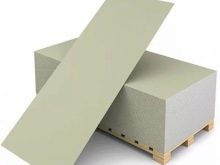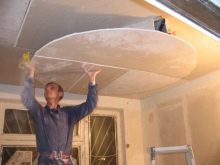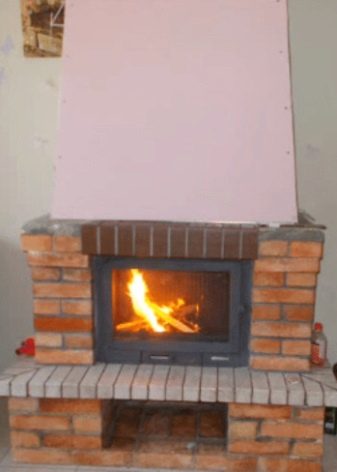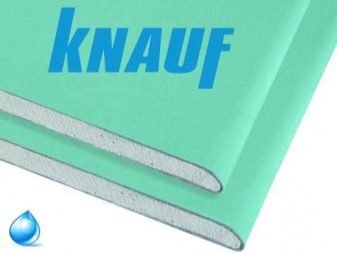Knauf drywall: properties and subtleties of use

Knauf drywall is a very popular material for interior decoration and is presented on the domestic market in a large assortment. With the help of this unique raw material, you can realize the most daring design ideas and author's interior compositions.



Peculiarities
Plasterboard sheets cut well with an ordinary sharp knife, and are also great for sawing and bending well. Elements of any shape can be cut out of the material, shaped holes of different sizes can be sawed. Plasterboard finishing times and labor costs are half as much as when performing the same amount of work using putty and plaster. Installation of gypsum board is carried out using screws, self-tapping screws, gypsum glue and special tape.




Specifications
Knauf drywall is produced in slabs and consists of gypsum sandwiched between two cardboard sheets. To give the material certain properties, various components are added to the gypsum. They improve strength, moisture resistance and ductility. Reinforcing, adhesive and modifying additives are used as additives. The material complies with GOST 6266-97, as well as certificates of the European standard DIN-18180.
Plasterboard is used to form multi-level ceiling structures, to decorate walls, create niches and arches, to erect partitions and create decorative interior elements. The color of the cardboard sheets corresponds to their specific properties. This facilitates the visual selection of materials at construction sites and in stores.




Dimensions (edit)
The dimensions of the sheets depend on the purpose of the drywall and can vary within 2-4 meters in length with a width of 60 and 120 cm. The thickness of the material is 6.5-24 mm. The most common size is 2.5x1.2 m with a thickness of 12.5 mm.


Life time
Knauf drywall is a fairly wear-resistant and durable material. Subject to the conditions of installation and operation, the service life is at least 25 years.
Advantages
Knauf gypsum plasterboard is considered the best-selling product in its category, due to a number of its indisputable advantages:
- low coefficient of thermal conductivity of the material eliminates heat loss and helps maintain a stable temperature regime in the room;
- high sound-absorbing properties make it possible to use gypsum board for finishing all types of residential and public buildings, while providing high protection of the premises from extraneous acoustic noise;

- complete environmental safety is due to the absence of toxic and toxic substances in the composition of the plates, which is confirmed by the necessary certificates of conformity;
- excellent moisture resistance and good water-repellent properties make it possible to use the material for finishing rooms with a high level of humidity, as well as with sharp temperature jumps and a tendency to condensation;
- the hygiene of the material guarantees the absence of harmful bacteria, as well as the appearance of mold and mildew;

- gypsum plasterboard surface is universal and suitable for cladding with all types of finishing materials;
- the ability of the material to absorb excess moisture, and, if necessary, give it back contributes to the formation of a favorable microclimate in the room;
- the incombustibility of drywall allows you to withstand the action of open fire, without igniting and not smoldering.

Scope of application
Knauf gypsum plasterboards are used for both interior and exterior finishes. The material is widely used for leveling walls and creating interior compositions. With its help, multilevel ceiling structures are formed, niches are built and interior and decorative partitions are erected. The ability of sheets to take rounded shapes allows you to implement unusual planning solutions when creating artistic images and provides a wide scope for designers' creativity.




Sheets are often used as sound insulation material. For this, straight or elongated perforated suspensions are attached to the wall or ceiling, which are mounted on a reinforced guide profile, followed by laying insulating material and drywall. Sealing is done using a special tape with further primer and surface filler. This technological solution will allow you to achieve excellent soundproofing results and ensure a comfortable stay in the room.
Views
Knauf has launched several modifications of this flexible, moisture resistant and refractory material.

According to the place of application, the following types of products are distinguished:
- wall - having a thickness of more than 12.5 mm and used for mounting vertical surfaces;
- ceiling - having a thickness of 9.5 millimeters, a weight of at least 30 kg, and intended for the formation of multi-level ceiling structures;
- arched, having a thickness of 6.5 mm, and used to create curved surfaces.



According to the operating conditions and the gypsum fillers used, the material is divided into four types.

- Drywall GSP-DFH 3IR is a very high quality, environmentally friendly product with high strength, shock resistance, increased density and moisture resistance. It is used for wall cladding, installation of suspended ceilings and the construction of interior partitions. The slabs are equipped with semicircular edges, which ensure the formation of tight joints. This type of gypsum board is manufactured in accordance with GOST 32 614 2012. The facing cardboard sheet has a blue color. The marking indicates the type of material, standard, type of longitudinal edges and dimensions. For example, a slab with semicircular edges, having a length of 2.5 m, a width of 1.2 m and a thickness of 12.5, will be marked as follows: DFH 3IR GOST - 32 614 2012 (EN 520 - 2009) PLUK 12.5 = 12 00 = 25 00.


The material is used as a base for all types of decorative finishes, including ceramic tiles and heavy wallpaper. When used in rooms with high humidity, the surface of the gypsum board must have a protective layer in the form of a waterproof primer, paint or tile. XTN screws should be used to secure this type of drywall. The area of one sheet is 3 m2, weight - 37.5 kg. The material complies with the KM1 fire safety class.

- Fire-resistant gypsum plasterboard GSP-DF is a product with increased resistance of the gypsum layer to the action of open fire. It is used for the construction of interior and decorative partitions, fire protection structures and suspended ceiling structures. The side edges are folded with the edges of the cardboard layer, the gypsum core is made using binders and reinforcements. The adhesion of cardboard sheets to the core is carried out by means of adhesives, which ensures the stability of the integrity of the plates and significantly increases their service life. The material is suitable as a base for all types of decorative topcoats and is approved for use in all types of residential and public spaces.


An example of marking a fire-resistant GKL sheet with dimensions of 2500x1200x12.5 mm: DF GOST 32 614 2012 (EN 52 = 2009) PLUK 12.5 = 12 00 = 25 00. This type of gypsum board can be used in low humidity conditions. The front side of the leaf has a pink tint, and the back is painted gray.The length of the slabs varies from 2 to 4 m with a width of 60 and 120 cm and a thickness of 12.5, 14 and 16 mm. The material has a very high fire resistance, flammability corresponds to the G1 indicator and is regulated by GOST 30244. The plates do not contain toxic substances and have a level of acidity similar to the acidity of the human body. Thanks to this, GCR can be used in children's and medical institutions, as well as used for decoration of premises for people suffering from allergic reactions.

- Waterproof gypsum plasterboard GSP-H2 is a gypsum building board, the core of which includes additives that reduce moisture absorption. GKL is used for the installation of suspended ceiling structures of different tiers, the creation of interior and decorative partitions and arches, and also as noise-absorbing structures in particularly humid rooms. Semicircular thinned edges are folded with cardboard edges and ensure tight joints between the boards.


The material is suitable as a base for any decorative topcoat, including wallpapering, tiling or painting. The absence of harmful components in the composition allows the use of drywall in any type of residential and public premises, including children's and medical institutions. GKLV is produced in lengths from 2000 to 4000 mm with a width of 600 and 1200 mm and a thickness of 6.5, 9.5, 12.5, 14 and 16 mm, it has the green color of cardboard casings. The most common size is 2500x1200x9.5 mm. The density of gypsum is 1250 kg / m3.


- Moisture-resistant gypsum plasterboard GSP-DF H2 combines the basic properties of moisture-resistant and fire-resistant types. This versatile non-combustible material is suitable for cladding with any kind of decorative coatings, it is used in the formation of multi-level ceiling structures, the creation of interior and decorative partitions, the construction of arches and niches, as well as for wall decoration. The side edge is folded with a front layer of cardboard and has a semicircular refined design. This helps to create the tightest joints between the slabs. The absence of toxic and toxic inclusions in the composition allows the use of gypsum board for finishing all types of premises.


The installation of components and the installation of drywall should be carried out before installing a clean floor at a temperature of at least 10 degrees, all wet, plumbing and electrical work should have already been completed. Before laying the slabs, they must undergo acclimatization in the repaired room if they were transported or stored in low temperatures. The material is well ventilated and provides a comfortable microclimate in the room. The sheets comply with all international standards and have the necessary certificates and approvals. The cardboard shell of the products is red. Plates are available in different sizes, the most common of which is 3000x1200x12.5 mm.

Reviews
Knauf drywall is a popular finishing material and has many positive reviews. Consumers note the high levels of environmental safety of the material and the possibility of its use in all types of living quarters, including children's rooms and bedrooms. Attention is also paid to the increased moisture resistance of drywall, which makes it possible to use it when decorating a bathroom, a toilet and a kitchen. This excellent soundproofing material reduces room acoustics. The advantages include the good elasticity of the sheets, thanks to which this flexible material makes it possible to implement bold architectural and planning solutions when decorating offices, apartments and public spaces. The availability and low cost of the material are also noted.


The disadvantages include the discrepancy between the color of the cardboard layer and the purpose of the material, which, although rare, still happens.Therefore, when buying, you need to focus not only on the color of the cardboard shell, but also carefully read the product labeling. This will help you choose the right type of gypsum board and finish the room in accordance with all the necessary standards.
A master class on the installation of a Knauf plasterboard ceiling, see below.













The comment was sent successfully.